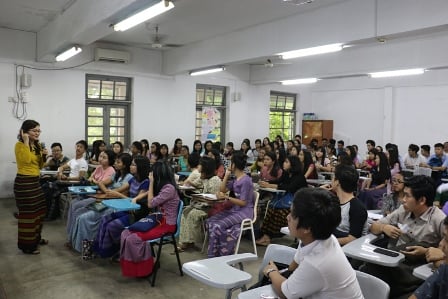YANGON, Myanmar – For decades, the lack of accurate and credible data has been an Achilles’ heel for journalists in Myanmar. With the scarcity of data sources, Myanmar journalists found it hard to reinforce their news stories with fact based evidence. There is a government run central statistics office that keeps nationwide data on many issues but it could not provide all the information that the media would like or at the speed they would like. Journalists who wanted data and other information, either at national or regional level, had to submit request to the government. Often, the request got lost in a myriad of bureaucracy, and the information release would be delayed or would sometimes never happen. The situation made journalists unable to write stories supported by data evidence.
The political and economic reforms beginning in early 2010s have accelerated the urgent need for accurate data. In 2014, with the support from UNFPA, the United Nations Population Fund, the Myanmar Government conducted a nationwide census – the first of its kind in more than three decades. The 2014 Myanmar Population and Housing Census has generated a wealth of data never before available in the country. The media plays an important role in analysing and interpreting data, and brining its implications on people and policy making to the attention of the general public as well as to decision makers. In 2016, UNFPA, together with UNESCO, began to build journalists’ capacity to access and use data in their jobs as media watchdogs.

Journalism students learn to use data to act as watchdogs
An important part of the initiative is to ensure that data journalism becomes a standard component of curriculum for journalism students. The ability to mine extensive datasets in search information and to turn this into fact-based news stories can be complex and it requires skills. At the National Management Degree College in Yangon, the students are now learning these skills, thanks to collaboration with UNFPA and UNESCO. Operating under the Ministry Education, the school offers the first-ever Bachelor of Arts degree in Journalism in Myanmar, and data journalism is now integrated into its third year undergraduate syllabus. Reports from the census provide key learning support, and students use the reports to develop their statistical, storytelling and watchdog proficiency.

“We are entering a new area for the media”
Kyaw Ko Ko Thet is 19 years old and a third year undergraduate studying journalism. He says, “I have heard the stories from the past when scarcity of data hampered the media a lot. Now, it’s quite different. We can literally say that we can access to data anytime, just a couple of mouse clicks.”
He is referring to latest census data available online. He explains that he has already downloaded the census numerical data online where it is available both on the UNFPA and the Department of Population websites. He explains, “The availability of data makes journalism much easier, and a lot more exciting. Now we can practice theories taught in classrooms with real and reliable data. It makes quite a difference compared to the old days.”
Kyaw Ko Ko Thet and his classmates’ course assignments include writing news stories and feature articles that rely on census data. He says, “I’m working on a story about labour force participation among youth aged between 15 and 19 years, particularly looking at the differences between urban and rural areas. I could not have provided evidence for my story without the census data or the skills to interpret it. My classmates and I are part of a whole new era for the media and for journalists.”



